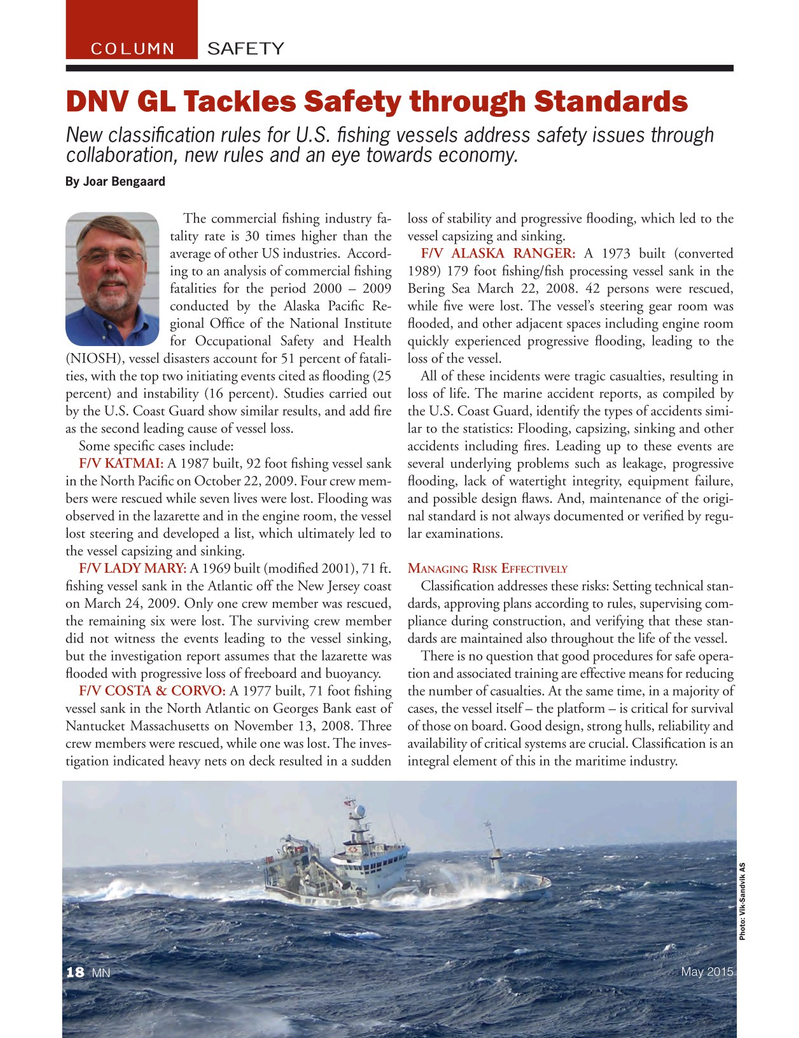
Page 18: of Marine News Magazine (May 2015)
Offshore Annual
Read this page in Pdf, Flash or Html5 edition of May 2015 Marine News Magazine
COLUMN SAFETY
DNV GL Tackles Safety through Standards
New classi? cation rules for U.S. ? shing vessels address safety issues through collaboration, new rules and an eye towards economy.
By Joar Bengaard
The commercial ? shing industry fa- loss of stability and progressive ? ooding, which led to the tality rate is 30 times higher than the vessel capsizing and sinking.
average of other US industries. Accord- F/V ALASKA RANGER: A 1973 built (converted ing to an analysis of commercial ? shing 1989) 179 foot ? shing/? sh processing vessel sank in the fatalities for the period 2000 – 2009 Bering Sea March 22, 2008. 42 persons were rescued, conducted by the Alaska Paci? c Re- while ? ve were lost. The vessel’s steering gear room was gional Of? ce of the National Institute ? ooded, and other adjacent spaces including engine room for Occupational Safety and Health quickly experienced progressive ? ooding, leading to the (NIOSH), vessel disasters account for 51 percent of fatali- loss of the vessel.
ties, with the top two initiating events cited as ? ooding (25 All of these incidents were tragic casualties, resulting in percent) and instability (16 percent). Studies carried out loss of life. The marine accident reports, as compiled by by the U.S. Coast Guard show similar results, and add ? re the U.S. Coast Guard, identify the types of accidents simi- as the second leading cause of vessel loss. lar to the statistics: Flooding, capsizing, sinking and other
Some speci? c cases include: accidents including ? res. Leading up to these events are
F/V KATMAI: A 1987 built, 92 foot ? shing vessel sank several underlying problems such as leakage, progressive in the North Paci? c on October 22, 2009. Four crew mem- ? ooding, lack of watertight integrity, equipment failure, bers were rescued while seven lives were lost. Flooding was and possible design ? aws. And, maintenance of the origi- observed in the lazarette and in the engine room, the vessel nal standard is not always documented or veri? ed by regu- lost steering and developed a list, which ultimately led to lar examinations.
the vessel capsizing and sinking.
F/V LADY MARY: A 1969 built (modi? ed 2001), 71 ft. M R E
ANAGING ISK FFECTIVELY ? shing vessel sank in the Atlantic off the New Jersey coast Classi? cation addresses these risks: Setting technical stan- on March 24, 2009. Only one crew member was rescued, dards, approving plans according to rules, supervising com- the remaining six were lost. The surviving crew member pliance during construction, and verifying that these stan- did not witness the events leading to the vessel sinking, dards are maintained also throughout the life of the vessel.
but the investigation report assumes that the lazarette was There is no question that good procedures for safe opera- ? ooded with progressive loss of freeboard and buoyancy. tion and associated training are effective means for reducing
F/V COSTA & CORVO: A 1977 built, 71 foot ? shing the number of casualties. At the same time, in a majority of vessel sank in the North Atlantic on Georges Bank east of cases, the vessel itself – the platform – is critical for survival
Nantucket Massachusetts on November 13, 2008. Three of those on board. Good design, strong hulls, reliability and crew members were rescued, while one was lost. The inves- availability of critical systems are crucial. Classi? cation is an tigation indicated heavy nets on deck resulted in a sudden integral element of this in the maritime industry.
Photo: Vik-Sandvik AS
May 2015 18 MN

 17
17

 19
19
